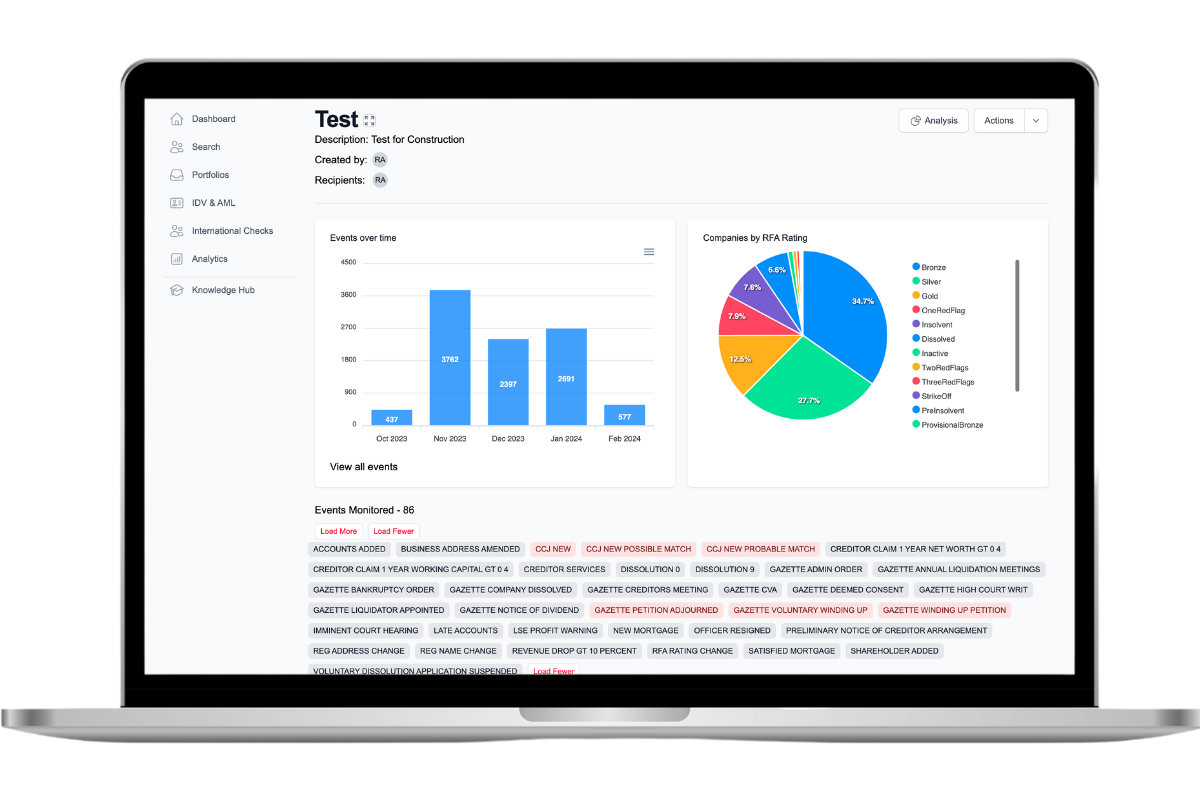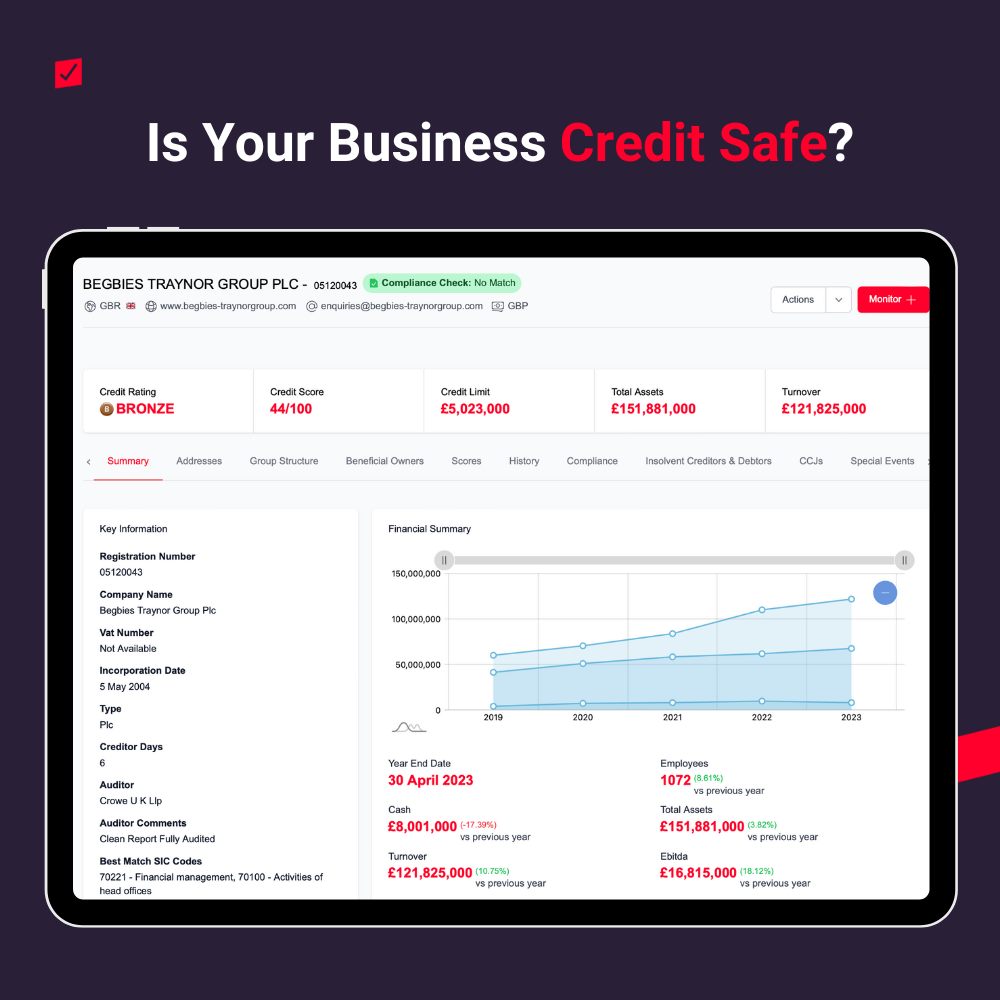Ensuring effective monitoring processes is a pivotal aspect of protecting your business and achieving success. It’s something many companies are aware of, but there is every chance they are monitoring inefficiently.
Without optimising these procedures, companies missing opportunities, overlooking financial troubles, and being caught off guard by insolvencies.
There’s also the high likelihood that traditional company monitoring efforts are draining resources, without delivering the risk mitigation and timely strategy adjustment support it should be.
Streamlining your processes is the solution to getting the most out of monitoring, without straining the business. Discover why Red Flag Alert takes monitoring seriously and why this passion led us to lead the charge in transforming monitoring into a proactive, effortless part of everyday life.
Why Red Flag Alert Company Monitoring is Vital for Business Success
Any business owner can appreciate how having oversight of clients, debtors, supply chains, prospects, and contractors can support a business. But, access to reliable, enriched data that supplies a clear view of portfolios holds more value than it may initially seem.
Closely monitoring clients and any changes in their situation can highlight an opportunity to upsell or cross-sell products and services. For example, if a business submits late accounts, accountancy firms may identify this as the right set of circumstances to offer their services.
This ability to understand prospective clients’ needs without prior communication allows businesses to offer targeted products or services that align with their interests, increasing sales revenue and customer satisfaction.
Beyond this, monitoring portfolio performance metrics enables businesses to identify underperforming customers and reallocate resources to more profitable partners. This is especially true for companies looking to engage in high-growth or high-margin industries to optimise their cost of acquisitions.
Supply chain management is also becoming an increasingly important aspect of modern business. As global supply chains become increasingly fraught being able to proactively react to potential supplier failure is a must.
Making quick decisions that will alter the current environment can be daunting, and companies shouldn’t be left with lacking data that doesn’t guide decisions.
Real-time monitoring provides timely insights into emerging risks and compliance issues, empowering management to make informed decisions quickly. With access to up-to-date information, businesses can assess risks more accurately and implement effective risk mitigation strategies.
How Traditional Monitoring is Holding Businesses Back
Traditional monitoring methods suffer from various practical limitations that leave businesses with unoptimised, inefficient results.
Not only is manual data entry time-consuming and error-prone, it can leave companies with inaccuracies and delays in tracking and analysing information. These fragmented systems result in disjointed data silos, making it challenging to obtain a comprehensive view of operations.
A lack of digital transformation also results in limited real-time insights, hindering timely decision-making, unresponsiveness to emerging risks and vulnerability to being outcompeted by those embracing technology.
Further drawbacks include:
- Time-consuming: Manual tracking methods require significant time and effort.
- Inaccuracy: Human error and outdated information can lead to inaccuracies.
- Limited scope: They often focus on a narrow set of metrics, providing an incomplete picture.
- Lack of real-time insights: Data is typically reported periodically, hindering timely decision-making.
- Difficulty in scalability: They may not be adaptable to growing business needs.
- Subjectivity: Human biases can influence data collection and analysis.
- Inability to detect subtle trends: They may miss subtle patterns or emerging issues.
- High cost: Long-term costs can accumulate due to manual labour and maintenance.
- Limited accessibility: Data may not be easily accessible to all stakeholders.
- Security concerns: Storing data in physical or digital formats can pose security risks.
Over time, these traditional methods hold back a business’ potential, stifling growth and increasing the chance of risk hitting a business leaving financial losses and reputational damage hanging in the balance.
These drawbacks of traditional monitoring methods highlight businesses’ need for modern, proactive monitoring solutions to mitigate risks effectively and drive business success.
The Role of Red Flag Alert in Overcoming Monitoring Challenges
To put into perspective how Red Flag Alert has transformed the monitoring process, we have broken down exactly how businesses can leverage the power behind our expertly designed tools.
For example, imagine a construction company using our services. They are already up against a disproportionate amount of insolvency threats and supply chain disruptions due to the nature of their industry, so how can they stay ahead of potential financial risk with Red Flag Alert?
Comprehensive Insight
When evaluating potential partners for an upcoming joint venture, the business can harness the comprehensive business data provided by Red Flag Alert. This deep dive into the financial histories and performance metrics of prospective collaborators enables them to make informed decisions and forge strategic alliances with confidence and speed.
Early Warning System
Before committing to a major supply contract, the business can access Red Flag Alert's predictive analytics to assess the financial stability of its prospective supplier. By identifying early warning signs of financial difficulties, such as liquidity reduction, they bolster due diligence processes, avoid potential disruptions to their supply chain and ensure project continuity.
Real-time Updates
Should the company begin a new project with a subcontractor, they can add the business into their portfolio with a few simple clicks, and immediately receive real-time alerts from Red Flag Alert.
In this case, they may be notified of potential financial troubles within the subcontractor’s organisation, receiving accessible analysis directly to their inbox. Armed with this timely information, they initiate a thorough review of the subcontractor's financial health before proceeding further.
Identification of Warning Signs
Once onboarded, the company may notice a pattern of late payments from a key client. Instead of digging through outdated information and missing data, Red Flag Alert's monitoring tools allow them to quickly recognise this as a warning sign of potential insolvency.
Proactively, they initiate discussions with the client to address payment issues and mitigate risks to their cash flow.
Automated Tracking
On a day-to-day basis, the business can rely on Red Flag Alert's automated tracking to monitor the financial health of its extensive network of suppliers and subcontractors. By effortlessly tracking late payments, non-payment of invoices, and cash flow issues, they ensure proactive management of potential risks.
Monitoring Legal Actions
As part of any risk management strategy, businesses should be able to monitor legal actions such as winding up petitions and County Court Judgments (CCJs). The business can instantly access data on Winding-Up Petitions and CCJs, being notified before anyone else, due to Red Flag’s industry-leading instant data integration.
Prevention Instead of Reaction
Unlike traditional reactive approaches to financial risk management, the business can prioritise prevention over reaction with Red Flag Alert's monitoring tools. By identifying creditworthy and reliable partners early on, they minimise the need for costly reactive measures such as bad debt protection, safeguarding their bottom line.
Customisable Monitoring System
Recognising the diverse needs of businesses, Red Flag Alert has incorporated highly customisable settings and preferences so users can tailor their monitoring approach to align with their unique risk profile and strategic objectives, maximising the effectiveness of their risk management efforts.
Reduced Risk of Human Error
With Red Flag Alert's comprehensive editing, filtering, and settings options, the business can have peace of mind knowing the risk of human error is removed. Instead, staff time is optimised and administrative burdens are removed, ensuring critical information is at their fingertips.
This is bolstered by alerts being shared across departments and project teams, fostering seamless communication and alignment. This transparent exchange of information ensures that crucial insights are not overlooked during staff absence, and refined alerts avoid email clutter to ensure swift and coordinated responses to emerging risks can be actioned.
Portfolio Analysis
By conducting regular portfolio analyses using Red Flag Alert's features, the business will be able to rely on consistent, valuable insights into the risk and health of their prospect and client lists. This holistic view of their operations enables them to identify interconnected risks and opportunities, optimising their business strategies for sustained success.
Upgrade Your Monitoring Today with Red Flag Alert!
So, do you think you’re monitoring correctly? It’s clear traditional monitoring methods have their limitations, and innovative solutions from Red Flag Alert have forged the path of success for many businesses that have taken the leap.
Leverage our real-time insights and accessible analysis tools to begin making agile, informed decisions in the blink of an eye.
Don't let traditional monitoring methods hold back your business potential. Embrace modern, proactive monitoring solutions with Red Flag Alert, and safeguard your success today and tomorrow. Experience the difference for yourself—schedule a free trial now.




